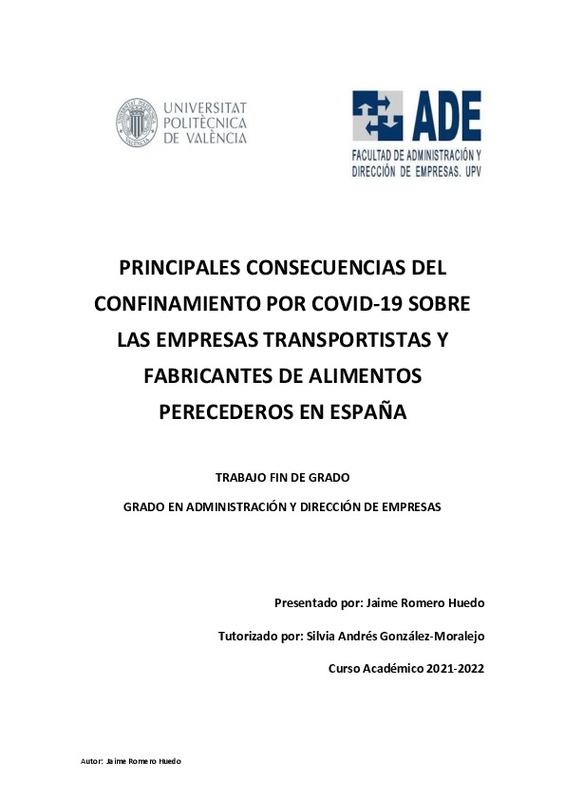|
Resumen:
|
[ES] El Covid-19 ha causado una crisis a nivel nacional y mundial sin precedentes en las últimas décadas. Durante todo el año 2020, la sociedad se vio expuesta a una situación de vulnerabilidad tanto a nivel sanitario como ...[+]
[ES] El Covid-19 ha causado una crisis a nivel nacional y mundial sin precedentes en las últimas décadas. Durante todo el año 2020, la sociedad se vio expuesta a una situación de vulnerabilidad tanto a nivel sanitario como económico, acentuada por un futuro incierto que cambiaba diariamente.
La industria alimentaria ha sufrido de primera mano las consecuencias de esta crisis. Por un lado, encontrándose con cambios en las tendencias de consumo desorbitados y, por otro, teniendo que hacer frente a una situación de excepcionalidad causada por el confinamiento, que impedía desarrollar de manera normal la actividad industrial.
El presente documento recopila datos cuantitativos extraídos directamente de las empresas cargadoras de alimentos perecederos. Estos datos ilustran la facturación real por servicios de transporte a sus clientes (los fabricantes de alimentos perecederos, mayoristas y empresas del canal HORECA), diferenciada por tipo de producto, y permiten su comparación con la facturación esperada durante los meses de confinamiento. Además, se realiza un exhaustivo análisis de los cambios en el consumo de los distintos tipos de alimentos perecederos durante el confinamiento, relacionando estos cambios con la facturación esperada y la facturación real de las empresas del sector.
Finalmente, se analiza la oportunidad que ha brindado esta crisis a las empresas del sector para realizar cambios estructurales, innovar y poder adaptarse a situaciones similares en un futuro.
[-]
[EN] The crisis caused by the Covid 19 pandemic has had important effects on the food sector. Its strategic role as a food supplier has become evident and it has faced significant challenges not only in providing this food ...[+]
[EN] The crisis caused by the Covid 19 pandemic has had important effects on the food sector. Its strategic role as a food supplier has become evident and it has faced significant challenges not only in providing this food but also in responding to changes in consumer requirements caused by population confinement and the rise of online commerce. , until now little used in the feeding channel. Despite the difficulties, the industry and distribution are achieving the supply of the population with great efficiency. The closure of the Horeca channel, the shortage of labor, financial needs, the difficulty in the foreign market, both for imports of raw materials and for the export of products, are affecting the different subsectors in an important and unequal way. and the differences in the size of the different actors or the relevance of short channels and proximity commerce are becoming more evident. To what extent are these objectives priorities in political action? Ultimately, this situation presents challenges and opportunities for manufacturers and shippers, who are facing problems of as yet unknown magnitude.
In this context, the purpose of this work is to find out the initial impact that the confinement of the Spanish population and the closure of the Horeca channel, decreed on March 14 as a result of the COVID 19 pandemic, has generated on loading companies and manufacturers of perishable food. Have the loader companies seen their activity increased or reduced? How are they adapting to the new requirements of their customers? In which sectors of the food industry have sales grown, in which sectors have they collapsed? Have some manufacturers been forced to cease their activity due to the closure of the Horeca channel or have they been able to reinvent themselves to survive? To answer these questions, the following specific objectives are set:
1. Analyze a sample of current transport contracts between manufacturing companies and loaders, comparing in each of them the expected billing level of the loader company (foreseen in their Business Plans at the end of 2019) with the executed billing level Really.
2. Diagnose in which subsectors and in which channels significant differences are perceived between expected and executed billing.
3. Explain in detail the response of the affected companies and their strategies in the face of the unprecedented crisis triggered by COVID 19, based on in-depth interviews with those responsible for the aforementioned contracts.
[-]
|







